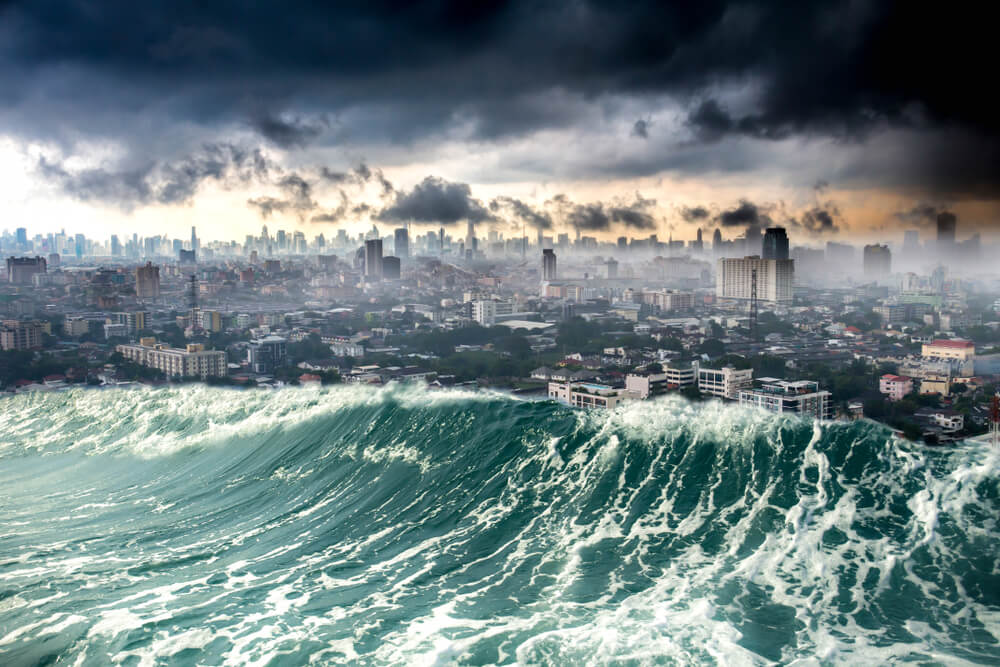Californians are afraid of a strong earthquake, but scientists say the threat from a tsunami could be worse
Scientists have long predicted a giant earthquake of magnitude 9,0 that will start from the Cascadia Fault in the Pacific Northwest and quickly send colossal waves rushing towards the shore. But what if these forecasts are missing an important piece of information that could tell an even more extreme story in certain scenarios? TheGuardian.

Photo: Shutterstock
A new study published last month in the peer-reviewed journal Earth-Science Reviews points to such a missing piece. The researchers found a previously unknown link between the strength of the tsunami generated by the earthquake and something known as the "outer wedge," the area between the earthquake's main fault and the sea floor.
Sylvain Barbeau, co-author of the study, described the outer wedge as a "garbage bag of subduction zones," a place where two tectonic plates crash into each other and can trigger an earthquake because that's where sediment builds up.
The researchers' findings show that the wider it is, the larger the maximum tsunami size will be.
This relationship adds a new element to be considered in tsunami forecasting. It, according to the authors, may mean increased risks of worst-case forecasts for some faults, including Cascadia.
On the subject: Scientists have learned to change the memory of genes: this is how alcoholism can be treated
“There are places where the outer wedge is tiny, so that's great news,” said Barbot, an assistant professor of geosciences at the University of Southern California. “And there are places where it is huge.” And this is the case in the Pacific Northwest.”
For about two years, he and his co-author Qiang Qiu of the South China Sea Institute of Oceanology studied 11 "tsunami-producing earthquakes" that have occurred around the world over the past 200 years. These rare events are associated with smaller earthquakes (the authors considered earthquakes with magnitudes from 7,1 to 8,2), which cause huge tsunamis and puzzle scientists for a long time.
They found a correlation between the maximum tsunami height and the outer wedge. The wider it is, as explained by Barbot, the more faults it has, the more likely it is to move the seabed and, therefore, the more powerful the tsunami can be.
These results were needed to make tsunami predictions in dozens of other active subduction zones around the "ring of fire", a nearly 40 km long path where most of the world's earthquakes occur.
At the top of this list was the Cascadia subduction zone, nearly 1000 km long. It runs from Vancouver Island in Canada to northern California and has a high probability of the next major earthquake. The last major earthquake occurred in 1700, and current estimates indicate a 15 percent chance of a magnitude 9,0 earthquake in the next 50 years.
A 2015 Pulitzer Prize-winning New Yorker article brought the subduction zone into the limelight, describing its next full-scale quake "as the worst natural disaster in North American history, outside of the 2010 Haiti quake."
The site, according to the authors, has a fairly large outer wedge (15 to 43 km long). According to their study, this suggests that a tsunami caused by an earthquake can reach heights of more than 61 meters. This is about twice as high as some of the more severe scenarios previously considered.
Compared to 30 other subduction zones analyzed by the authors of the study, Cascadia ranked fifth in terms of tsunami severity. According to the authors, it is located behind such subduction zones as Makran (in Pakistan and Iran), Aleutian (in Alaska), and Lesser Antilles (in the Caribbean Sea).
You may be interested in: top New York news, stories of our immigrants, and helpful tips about life in the Big Apple - read it all on ForumDaily New York.
Barbeau explained that the findings needed further testing, but that they could eventually lead not only to changes in tsunami forecasts, but also to emergency preparedness in those regions.
“If you're preparing for a 30-meter tsunami and a 60-meter tsunami comes, you need to double the height of your evacuation zones,” he said. “You need to change where you plan to build infrastructure, such as hospitals and schools. It also changes, in a more practical sense, the cost of insuring real estate. This significantly changes risk and how it is distributed across space.”
But of course, this outer wedge is not the only variable that can affect the size of a tsunami. There are many other factors, including the slope of the seabed and the general topography.
Harold Tobin, director of the Pacific Northwest Seismic Network and professor of earth and space sciences at the University of Washington, cautioned that while this study shows an interesting new finding, further research is needed to fully account for these other variables.
He explained that it would be premature to draw any conclusions or start changing how the Pacific Northwest or other areas prepare for a tsunami.
“What we need to do is take into account the evidence this paper has given us to build better models for all of this; to clarify and improve the scenarios they are preparing for,” Tobin said. “But that in itself doesn't mean we need to suddenly say, 'Okay, the tsunami risk has doubled.' "This simply points to one possible mechanism that may mean the tsunami hazard may be greater than previously thought."
Read also on ForumDaily:
Mass shooting in Philadelphia: 3 dead, 11 injured
Russia's nuclear doctrine: whom and why the Kremlin is ready to fire rockets
Subscribe to ForumDaily on Google NewsDo you want more important and interesting news about life in the USA and immigration to America? — support us donate! Also subscribe to our page Facebook. Select the “Priority in display” option and read us first. Also, don't forget to subscribe to our РєР ° РЅР ° Р »РІ Telegram and Instagram- there is a lot of interesting things there. And join thousands of readers ForumDaily New York — there you will find a lot of interesting and positive information about life in the metropolis.











